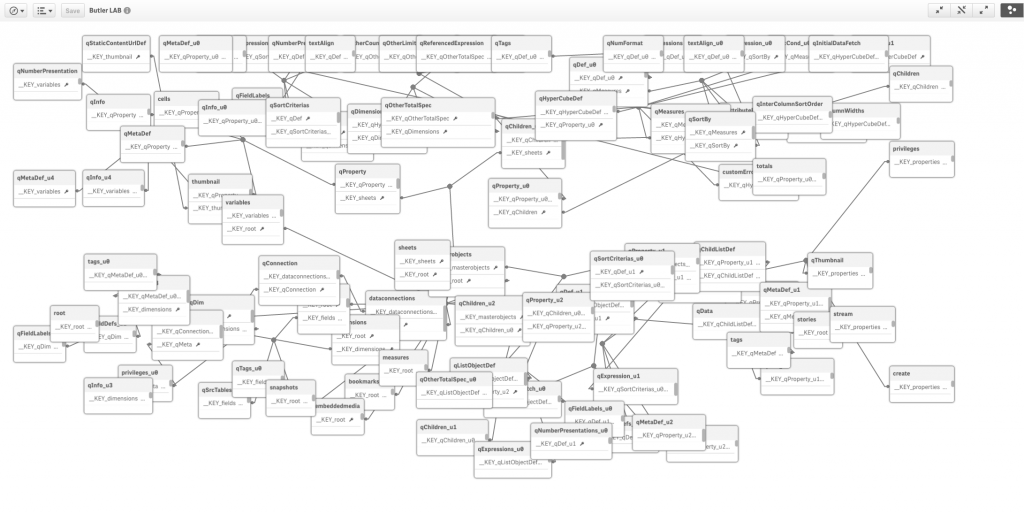Sense app introspection and metadata
Examples of how to extract metadata and structural information from Qlik Sense apps using Butler's REST API.
These examples show how to:
- List all apps on a Sense server
- Serialize a Sense app's internal structure to JSON
- Analyze app data models from within other Sense apps
List all Sense apps on the server
Get a list of all apps available on the Sense server, including their IDs and names.
This is useful for:
- Building app inventories
- Creating app monitoring dashboards
- Dynamically selecting apps for processing
- Automating app management tasks
Setup
Create a data connection called "Sense list apps" using Qlik's standard REST connector, connected to:
http://<FQDN or IP of Butler server>:8080/senseListAppsLoad Script
The following script will load all app IDs and names into a table:
// "Sense list apps" is a data connection using Qlik's standard REST connector, connected
// to http://<FQDN or IP of Butler server>:8080/senseListApps
// The Apps table will contain id and name of all apps on the server
LIB CONNECT TO 'Sense list apps';
RestConnectorMasterTable:
SQL SELECT
"id",
"name"
FROM JSON (wrap on) "root";
Apps:
LOAD
[id] AS [App id],
[name] AS [App name]
RESIDENT RestConnectorMasterTable;
DROP TABLE RestConnectorMasterTable;Serialize a Sense app to JSON and extract data model
Extract the complete internal structure of a Sense app as JSON, then load it into another Sense app for analysis.
This is useful for:
- Analyzing app structure and complexity
- Building app documentation automatically
- Comparing apps to identify differences
- Creating app templates or patterns
- Understanding relationships between objects in apps
Setup
Create a data connection called "Sense app extract" using Qlik's REST connector, against:
http://<FQDN or IP of Butler server>:8080/senseAppDumpThis will generate several thousand lines of code in the Sense script editor, modeling a Sense app's internal data model. The Butler endpoint returns JSON, which the REST connector then transforms into a Sense data model.
Load Script
To dynamically control which app is serialized, use the "with connection" syntax:
LIB CONNECT TO 'Sense app extract';
let vAppId = 'abcd1234-5678-abcd-1234-abcd1234abcd';
RestConnectorMasterTable:
SQL SELECT
"loadScript",
...
FROM JSON (wrap on) "root" PK "__KEY_root"
WITH CONNECTION (
QUERY "guid" "$(vAppId)");
...Result
Here is what the Sense data model can look like for a serialized Sense app:

Data model visualization of a Qlik Sense app's internal structure
The data model contains detailed information about:
- App properties and metadata
- Load script content
- Sheets and visualizations
- Dimensions and measures
- Variables and expressions
- Data connections
- And much more...
Use Cases
App Inventory and Monitoring
Load app metadata into a monitoring app to track:
- Total number of apps
- App sizes and complexity
- Last reload times
- App ownership and access
App Analysis and Documentation
Use the serialized app structure to:
- Generate documentation automatically
- Identify unused objects or fields
- Find performance bottlenecks
- Create dependency maps between apps
App Migration and Templating
Extract app structures to:
- Create reusable app templates
- Compare development vs. production apps
- Migrate apps between environments
- Standardize app structures across teams
See Also
- Sense demo apps - Example apps demonstrating Butler features
- Butler API documentation - Complete REST API reference
- Butler helper functions - Load script helper functions